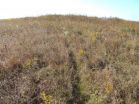(Press-News.org) For soil microbiology, it is the best of times. While no one has undertaken an accurate census, a spoonful of soil holds hundreds of billions of microbial cells, encompassing thousands of species. "It's one of the most diverse microbial habitats on Earth, yet we know surprisingly little about the identities and functions of the microbes inhabiting soil," said Jim Tiedje, Distinguished Professor at the Center for Microbial Ecology at Michigan State University. Tiedje, along with MSU colleagues and collaborators from the U.S. Department of Energy Joint Genome Institute (DOE JGI) and Lawrence Berkeley National Laboratory (Berkeley Lab), have published the largest soil DNA sequencing effort to date in the March 10, 2014, issue of Proceedings of the National Academy of Sciences (PNAS). What has emerged in this first of the studies to come from this project is a simple, elegant solution to sifting through the deluge of information gleaned, as well as a sobering reality check on just how hard a challenge these environments will be.
"The Great Prairie represents the largest expanse of the world's most fertile soils, which makes it important as a reference site and for understanding the biological basis and ecosystem services of its microbial community," said Tiedje. "It sequesters the most carbon of any soil system in the U.S. and produces large amounts of biomass annually, which is key for biofuels, food security, and carbon sequestration. It's an ecosystem that parallels the large ocean gyres in its importance in the world's primary productivity and biogeochemical cycles."
Since the release of the first human genome over a decade ago, the applications of DNA sequencing have been extended as a powerful diagnostic technique for gauging the health of the planet's diverse ecological niches and their responsiveness to change. In this ambitious pilot study launched by the DOE JGI, MSU researchers sought to compare the microbial populations of different soils sampled from Midwestern corn fields, under continuous cultivation for 100 years, with those sourced from pristine expanses of the Great Prairie. The rationale is no less compelling than the original motivations underlying the Human Genome Project.
The Great Prairie soil project is also the kind of demanding initiative ideally suited for the DOE JGI which provided the raw sequencing power to actually do it. Beyond the throughput required to generate enough data, a key factor that makes soil a "Grand Challenge" of biology is that there are precious few reference genomes, "Rosetta Stones," to help sift through these data for the nuggets that may inform important traits like agricultural productivity, carbon cycling, nutrient processing, or disease and drought resistance. Another is the sheer scale of the analyses necessary for the vast amount of raw data. For the Great Prairie soil experiment, the team generated nearly 400 billion letters of code, which amounts to more than 130 human genome equivalents, or 88,000 E. coli genomes.
"This is like shredding the contents of an entire library and reassembling an individual volume out of that massive pile of shreds," said the study's lead author, C. Titus Brown of Michigan Statue University, who uses this analogy for how traditional "shotgun" DNA sequencing of environment samples works. Brown likes to use Charles Dickens' "A Tale of Two Cities," as the particular book in explaining the technique (...it was the age of wisdom, it was the age of foolishness...).
The analytic approach used on the prairie samples was first tried out on a recently characterized data set from the study of the human gut microbiome—the community of microorganisms that live inside us. Brown and his colleague, first author Adina Chuang Howe, deployed a compression method, common with large computer files such as JPEG images conveyed through the internet, that allows a substantial amount of data to be discarded without the actual data content being degraded. Brown calls the technique "digital normalization."
Having tested it on the gut data set, they applied it to the soil set. "These results still continue to stun me," said Brown. "What this gives us is a 2 to 200-fold decrease in computational requirements for the actual biological analysis."
The key point, Brown said, is that in addition to making hard analysis easier and impossible analysis—soil metagenomes, in particular—approachable, the process dramatically improves genome assembly of difficult organisms, and makes transcriptome assembly (of the RNA molecules that encode proteins expressed by the genome) trivial. Moreover, it offers a data management "democratization" empowering scientists who don't have access to cloud- and high-performance computing, to analyze them.
"I think this can lead to a fundamental shift in thinking," Brown said. "We are actually converting standard, heavyweight approaches in biological sequence analysis to an ultra-efficient streaming approach." Consequently, researchers can devote more resources to extracting science from the noise, as their basic analysis expenditures have dropped.
As for the actual biology of the soil, the analysis is still in the works. But in the meantime, the implications for use of this simple, elegant strategy abound.
Janet Jansson, senior staff scientist from Berkeley Lab's Earth Sciences Division, along with Susannah Tringe, head of the DOE JGI's Metagenome Program, championed the project with the DOE's mission in mind.
"It has been our ambition to improve the ability to link genetic information to ecological function with the potential to yield diagnostic tools for improved soil management, carbon sequestration, ecosystem services, and productivity," said Jansson, who has traveled to the remote expanses of the Arctic to sample the microbial communities coming to life in melting permafrost.
"Metagenomic sequence analysis has provided the means to better understand the function of soil communities in general as well as differences and similarities in composition, diversity, and function in different soil ecosystems."
Digital normalization should enable significant improvement in genome assembly, she said, and provide the critical references to advance future investigations of soils and other complex environments.
"This will help us establish patterns of how genes and organisms evolve in soil, and how these can be used to understand and potentially manage adaptive traits such as greenhouse gas fluxes, carbon stability, and plant disease development," Jansson said. "What we do know now is that soil microbes are responsible for cycling nutrients that are of critical importance for all higher forms of life. The role of soil microbes in carbon cycling is one example that has recently been highlighted due to the importance of microbial-mediated uptake and sequestration of carbon as well as the converse processes of organic matter degradation and release of CO2 and methane to the atmosphere. The relative balance between these processes has enormous implications for the atmospheric carbon budget and subsequent global warming trends."
The bottom line of the PNAS study is that despite 400 billion bases of data, it was still insufficient to interrogate the microbial players in the localized soil sample deeply enough, confirming that much more data are needed to study the content of soil metagenomes comprehensively.
Or, to paraphrase another one of Charles Dickens' characters, said Brown, "please sir, can we have some more...data."
INFORMATION:
In addition to the support provided by the DOE Office of Science, this research was supported by the US Department of Agriculture, National Institute of Food and Agriculture, the National Science Foundation and the Great Lakes Bioenergy Research Center.
For more information about C. Titus Brown's work, see the short video
Efficient streaming approaches to biological data analysis:
http://youtu.be/rzScrmakgfA
The U.S. Department of Energy Joint Genome Institute, supported by the DOE Office of Science, is committed to advancing genomics in support of DOE missions related to clean energy generation and environmental characterization and cleanup. DOE JGI, headquartered in Walnut Creek, Calif., provides integrated high-throughput sequencing and computational analysis that enable systems-based scientific approaches to these challenges. Follow @doe_jgi on Twitter.
DOE's Office of Science is the largest supporter of basic research in the physical sciences in the United States, and is working to address some of the most pressing challenges of our time. For more information, please visit science.energy.gov.
A tale of 2 data sets: New DNA analysis strategy helps researchers cut through the dirt
2014-03-10
ELSE PRESS RELEASES FROM THIS DATE:
Mecasermin (rh-IGF-1) treatment for Rett Syndrome is safe and well-tolerated
2014-03-10
(Cincinnati, OH) – The results from Boston Children's Hospital's Phase 1 human clinical trial in Rett syndrome came out today. A team of investigators successfully completed a Phase 1 clinical trial using mecasermin [recombinant human insulin-like growth factor 1 (IGF-1)], showing proof-of-principle that treatments like IGF-1 which are based on the neurobiology of Rett syndrome, are possible. The study deemed that IGF-1 is safe and well tolerated in girls diagnosed with Rett syndrome, and the data also suggests that certain breathing and behavioral symptoms associated ...
National study reveals urban lawn care habits
2014-03-10
(Millbrook, NY) What do people living in Boston, Baltimore, Miami, Minneapolis-St. Paul, Phoenix, and Los Angeles have in common? From coast to coast, prairie to desert – residential lawns reign.
But, according to a new study in the Proceedings of the National Academy of Sciences, beneath this sea of green lie unexpected differences in fertilization and irrigation practices. Understanding urban lawn care is vital to sustainability planning, more than 80% of Americans live in cities and their suburbs, and these numbers continue to grow.
The study was undertaken to ...
Lower IQ in teen years increases risk of early-onset dementia
2014-03-10
Men who at the age of 18 years have poorer cardiovascular fitness and/or a lower IQ more often suffer from dementia before the age of 60. This is shown in a recent study encompassing more than one million Swedish men.
In several extensive studies, researchers at the Sahlgrenska Academy of Gothenburg University have previously analyzed Swedish men's conscription results and were able to show a correlation between cardiovascular fitness as a teenager and health problems in later life.
Increased risk for early-onset dementia
In their latest study, based on data from 1.1 ...
Some characteristics increase the likelihood of getting married and living together
2014-03-10
CORAL GABLES, FL (March 10, 2014) -- When it comes to romantic relationships, attributes such as health, kindness, and social status have been shown to be important qualities in choosing a partner. It may be surprising to learn, however, that certain personal traits predispose a person towards either getting married or forming a cohabitating relationship.
According to a study recently published in the journal Social Science Research, scoring high on attractiveness, personality, and grooming is associated with a greater probability of entering into a marital relationship ...
A shocking diet
2014-03-10
There have been plenty of fad diets that captured the public's imagination over the years, but Harvard scientists have identified what may be the strangest of them all – sunlight and electricity.
Led by Peter Girguis, the John L. Loeb Associate Professor of the Natural Sciences, and Arpita Bose, a post-doctoral fellow in Organismic and Evolutionary Biology, a team of researchers showed that the commonly found bacterium Rhodopseudomonas palustris can use natural conductivity to pull electrons from minerals located deep in soil and sediment while remaining at the surface, ...
Ben-Gurion U. researchers identify severe genetic disease prevalent in Moroccan Jews
2014-03-10
BEER-SHEVA, Israel, March 10, 2014 - Ben-Gurion University of the Negev (BGU) researchers have unraveled the genetic basis of a hereditary disease that causes severe brain atrophy, mental retardation and epilepsy in Jews of Moroccan ancestry, according to a study published this week online in the Journal of Medical Genetics.
The disease, which the researchers have called PCCA2 (Progressive Cerebello-Cerebral Atrophy Type 2), is caused by two mutations in the VPS53 gene. It results in defective circulation of vacuoles (endosomes) within patents' cells and leads to detrimental ...
Penn researchers model a key breaking point involved in traumatic brain injury
2014-03-10
Even the mildest form of a traumatic brain injury, better known as a concussion, can deal permanent, irreparable damage. Now, an interdisciplinary team of researchers at the University of Pennsylvania is using mathematical modeling to better understand the mechanisms at play in this kind of injury, with an eye toward protecting the brain from its long-term consequences.
Their recent findings, published in the Biophysical Journal, shed new light on the mechanical properties of a critical brain protein and its role in the elasticity of axons, the long, tendril-like part ...
Predation on invertebrates by woodland salamanders increases carbon capture
2014-03-10
ARCATA, Calif.—Woodland salamanders perform a vital ecological service in American forests by helping to mitigate the impacts of global warming.
Global warming occurs when greenhouse gases like carbon dioxide are released into the atmosphere. Woodland salamanders facilitate the capture of this carbon before it is released by feeding on invertebrates (beetles, earthworms, snails, ants, etc.) that would otherwise release carbon through consumption of fallen leaves and other forest debris. Woodland salamanders are the most common vertebrate species in American forests; consequently, ...
Parkinson's disease: Quickly identifying patients at risk of dementia
2014-03-10
This news release is available in French. It may now be possible to identify the first-stage Parkinson's patients who will go on to develop dementia, according to a study conducted at the Institut universitaire de gériatrie de Montréal by Dr. Oury Monchi, PhD, and his postdoctoral student, Dr. Alexandru Hanganu, MD, PhD, both of whom are affiliated with Université de Montréal. These findings were published in the journal Brain.
Although Parkinson's disease is generally associated with motor problems such as trembling or rigidity, people with this disease actually ...
NASA satellites eye troublesome Tropical Cyclone Lusi
2014-03-10
Tropical Cyclone Lusi has spawned warnings and watches in the Solomon Islands, Vanuatu, and New Zealand as it moves through the South Pacific Ocean. NASA's Terra and Aqua satellites provided visible and infrared views of the storm that revealed it has become better organized.
NASA's Terra satellite captured a visible image of Tropical Cyclone Lusi over Vanuatu on March 9 at 23:30 UTC. The image showed towering thunderstorms surrounded the center and northwestern quadrants of the storm.
The next day at 02:17 UTC, NASA's Aqua satellite passed over Lusi and captured infrared ...






